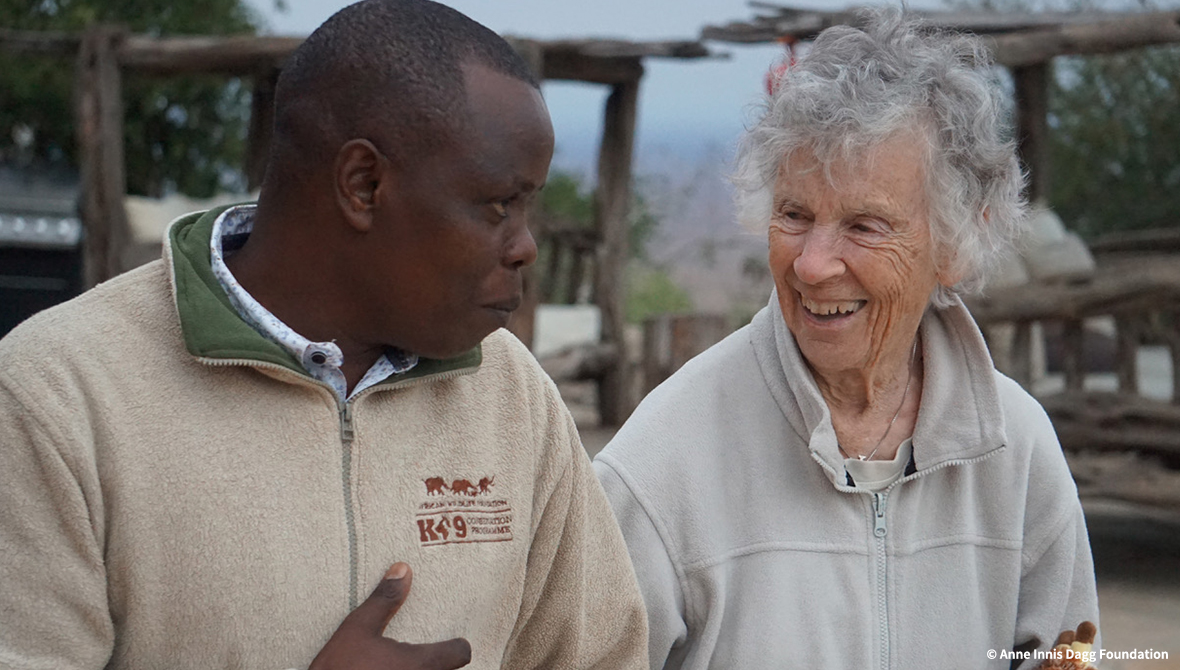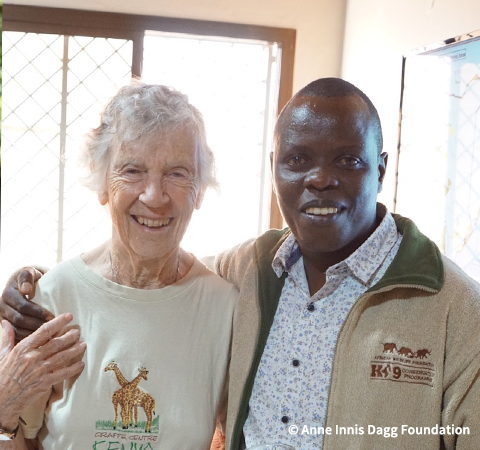Honoring the Legacy of Dr. Anne Innis Dagg: A Giraffe Conservation Icon

Dr. Anne Innis Dagg, a renowned zoologist who passionately supported the African Wildlife Foundation's (AWF) work in giraffe conservation, passed away earlier this month. Known to many as the woman who loved giraffes, Dr. Anne was celebrated for her foundational contributions to giraffe science and advocacy for women in academia.
In 1956, at the age of 23, Dr. Anne made history as the first Western scientist to study giraffes in the wild during a solo trip to South Africa. Her book, "Giraffe: Biology, Behaviour and Conservation," is considered the definitive guide on giraffes and continues to be used by scientists today.
In 2021, AWF joined forces with Dr. Anne’s Foundation, the Anne Innis Dagg Foundation, to protect giraffes in the Tsavo-Mkomazi landscape, a vital transboundary area for giraffes ranging between southern Kenya and northern Tanzania. The partnership aimed to counter giraffe poaching and conserve giraffe populations in their natural environments to benefit the species and people.
We asked AWF's chief scientist, Dr. Phillip Muruthi, to reflect on Anne's impact on giraffe conservation and AWF's work. He last caught up with her during a visit to Tsavo last year.
Q: How would you describe Dr. Anne Innis Dagg's impact on giraffe conservation in Africa?
Philip: Dr. Anne Innis Dagg was a true pioneer in giraffe conservation. Even before founding the Anne Innis Dagg Foundation in the 1960s, she ventured into the field in Africa, becoming the first woman to study giraffes in their natural habitat; a great feat then and now. Her groundbreaking research not only increased our understanding of giraffes but also raised global awareness about their conservation needs. Dr. Anne's dedication to giraffe conservation paved the way for future researchers and conservationists, inspiring a new generation to protect these magnificent creatures.
Q: Can you elaborate on Dr. Anne's advocacy for women's rights and its connection to her work in giraffe conservation?
Philip: Dr. Anne was a trailblazer in giraffe conservation and a staunch advocate for women's rights. Her interest in giraffe conservation was closely intertwined with her desire to create opportunities for women in academia and conservation. Throughout her career, Dr. Anne faced significant challenges, including struggles to secure tenure as a professor due to gender discrimination. Her resilience and determination inspired many, earning her recognition from numerous organizations and awards for her groundbreaking work. In her later years, Dr. Anne reaffirmed her dedication to Africa and giraffes by establishing the Anne Innis Dagg Foundation and collaborating with organizations like the African Wildlife Foundation to continue her conservation efforts.

Q: How has Dr. Anne's support influenced AWF's giraffe conservation efforts?
Philip: Dr. Anne's support has been instrumental in advancing giraffe conservation initiatives in Kenya and Tanzania. Through the Anne Innis Dagg Foundation, she provided funding and assistance to AWF, enabling us to expand our giraffe conservation programs in key landscapes such as the Tsavo-Mkomazi. Her contributions allowed us to work closely with local communities, government agencies, and conservation partners to ensure the long-term survival of giraffes and their habitats. We have implemented successful anti-poaching initiatives in the Tsavo-Mkomazi landscape, leading to a significant decrease in illegal offtake incidents, enhanced local community involvement, and corresponding giraffe stabilization and population growth.
Moreover, the establishment of a tracker dog unit in partnership with Mkomazi National Park has bolstered our anti-poaching efforts, with the unit participating in over 86 patrols and assisting in the arrest of more than 12 poachers in 2023. Additionally, we have trained community wildlife scouts and equipped wildlife monitors and district game officers with cyber tracker devices and laptops. This comprehensive approach strengthens our overall anti-poaching efforts, safeguarding not only giraffes but also a wider range of wildlife species in the Tsavo-Mkomazi Landscape.
Furthermore, Dr. Anne's support has enabled us to conduct community sensitization meetings and deliver conservation education programs to primary and secondary schools. This investment in education fosters long-term understanding and appreciation for giraffes and their crucial role in the ecosystem, laying the foundation for sustainable conservation efforts.
Q: In what ways did Dr. Anne inspire and mentor others in giraffe conservation?
Philip: Dr. Anne's passion for giraffe conservation inspired countless individuals to pursue careers in wildlife conservation. Her pioneering research and advocacy efforts demonstrated the importance of studying and protecting giraffes in Africa. Through her mentorship and encouragement, she empowered researchers, conservationists, and aspiring biologists to make a difference in the field of giraffe conservation.
Q: How do you envision Dr. Anne's legacy shaping giraffe conservation moving forward?
Philip: Dr. Anne's legacy will undoubtedly continue to influence giraffe conservation efforts for years. Her commitment to wildlife conservation and dedication to protecting giraffes have left an indelible mark on the conservation community. As we honor her memory, we remain committed to building upon her legacy by safeguarding giraffes and their habitats, promoting community involvement, and advocating for their protection on a global scale.
